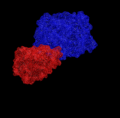| |
 |
Should you encounter any unexpected behaviour,
please let us know.
|
elNémo examples
E. coli membrane channel protein TolC
(1ek9)
Here we model
the putative TolC opening/closing of the outer-membrane part of TolC (beta-barrel).
TolC is a homo-trimer. Each monomer is indicated by a separate color (blue, white, red:-)
The animation follows the fifth lowest frequency mode (11) with an equal perturbation in both
directions from the crystallographic state.
See how the channel exit opens and closes!
|

|

|

|
|
TolC from the side
|
TolC viewed inside-out
|
View into TolC
|
E. coli membrane associated protein TolB
(1crz)
This eample shows how
the periplasmic domain of TolB (red) might act as a lid on the membrane bound beta-barrel (blue).
Watch the channel in the middle of the blue domain being covered by the red lid!
This movement follows the second lowest frequency normal mode (mode 8).
Note that the protein distortion may appear somewhat "unrealistic"
since the movement applied here "overstresses" the linear perturbation that is assumed
in any harmonic oscillator.
|

|

|

|
|
TolB viewed from outside the cell
|
TolB from the side
|
TolB seen from a periplasmic position
|
All images were produced with VMD using the Tachyon ray tracer.
Surface plots were made using MSMS via the VMD interface.
If you find results from this site helpful for your research, please cite one of our papers:
elNémo
is maintained by Yves-Henri Sanejouand.
It was developed
by Karsten Suhre.
Between 2003 and 2014, it was hosted by IGS (Marseille).
Last modification: April 8th, 2025.
|
|
 |
 |
|












